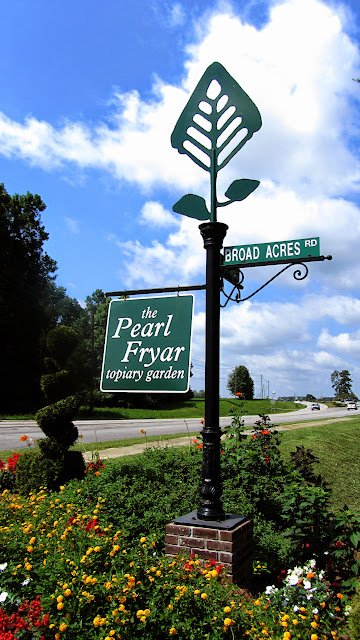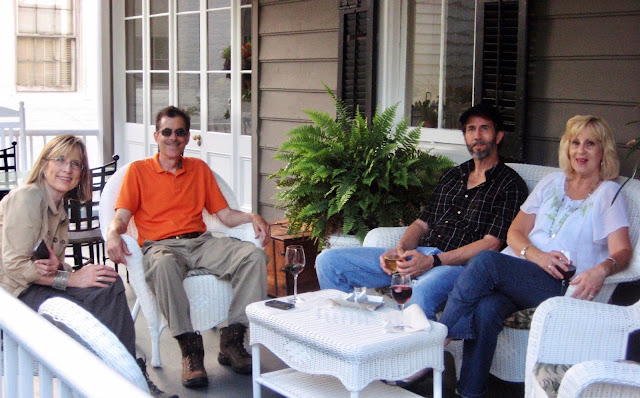During her children's growing years, Jeanne nurtured them on a steady diet of historical information, civic lessons, and geography trivia. Today any one of them could probably win a spot on
Who Wants to Be a Millionaire. This week, she would continue the tradition with another generation. Jeanne's daughter Gina, mother of two of the cousins, offered to host us at her home and volunteered for chauffeuring duty for the week.
space
As the symbol and seat of local government, courthouses would be the focus of our touring with an introduction to letterboxing and geocaching thrown in to spice things up a bit. Monday afternoon found us invading the Forrest County Courthouse in Hattiesburg
(pictured above).
space Following what would become a routine photo op on the courthouse steps and at the site of the county's Confederate Monument, we made our way into the building. Though the VBS teachers had done their best to adrenalize the kids, the cousins curbed their hyperactivity and noise level when we entered the government building and became absorbed in their grandmother's tour.
After a brief visit to the courtroom, where probation revocation hearings were wrapping up for the day, we completed the Forrest County Courthouse tour and trekked over to the Hattiesburg Cultural Center nearby to search for a letterbox. Here the kids learned one of the basic lessons of this hobby—sometimes the box has gone missing. Retracing our steps toward the courthouse on the way to Veterans Memorial Park, we passed the office of U.S. Congressman Steven Palazzo, who represents Mississippi's 4th Congressional District. Upon entering, we learned that Representative Palazzo was in Washington that day, but his Hattiesburg office staff was very congenial, and we jumped on their suggestion for a group photo in the office. These young constituents were especially impressed with the congressman's gold-embossed business cards that the staff distributed.
 |
| Young constituents of Rep. Palazzo |
At Veterans Memorial Park, the search began for the kids' first geocache. The hint for the cache suggested it was on or near a place to sit, but the park was equipped with two dozen or so benches, and with the temperature at 95°, discouragement was an easy option. In what would become a pattern, Carson (age 10) persevered in the quest until he tracked down the treasure, a tiny magnetic box hidden on the underside of a bench.
Drenched in perspiration, we were all thrilled to return to the oasis of the air-conditioned car, but the best relief for the kids came after we returned to the Hudson home for the day. A long playtime in the pool became a late afternoon routine. They invented clever games to keep them splashing and frolicking until dinner time. Not only was it fun, pool time absolved the kids from the requirement for a daily bath. What could be better?
 |
| The cousins: Carson, Alex, Andrew, Avery and Lizzie, plus neighbor Hayden |
Even though Alex and Avery live in Hattiesburg, they are not residents of Forrest County. The metropolitan area is split between Forrest County and Lamar County, where their house is located. So on Tuesday, we set our sights on Purvis, the county seat of Lamar County. As we drove, the kids were mesmerized by the story of a 1908 F-4 tornado that demolished most of the town and killed 83 residents. Mr. Thomas Purves, for whom the town was named, also captured their imagination when they learned that he changed the spelling of his surname after the railroad mistakenly named the town Purvis.
A shiver ran down our spines when we exited the car upon our arrival and noticed that the time on the town clock in the old courthouse dome was 2:15, just two minutes later than the time the clock had been stopped when the dome was torn down by the tornado 105 years earlier. When they discovered the tornado memorial on the courthouse grounds, the cousins were especially touched by the listing of victims' names on the back, saddened when they noticed that by the time the monument was constructed 100 years after the event, the names of some of the children who perished had been lost to history.
 |
| At the old Purvis train depot |
Though a new Lamar County Courthouse opened next door in 2009, finishing touches were underway in a massive renovation of the 1905 building, which will again house some county courts and offices. We were invited to see the new state of the art courtroom with video panels for each juror and noted that the restoration included the return of the dome and clock atop the structure.
After checking out both courthouses, we sought out the town library, where a geocache was hidden. When we arrived, we found more than we were expecting. The old Purvis depot, which had been tossed across the tracks by the tornado, had been restored and moved to a location next to the library. In front of the old building was a bust of none other than Mr. Purves himself. Carson again spied the geocache first, and this one was large enough to house "swag," small, inexpensive trinkets that geocachers like to trade when they find caches. Needless to say, the cousins found this new aspect of the hobby quite to their liking, especially since Grandmother Jeanne had planned ahead and brought some items for them to trade.
While at the library, we also left a letterbox that we had created to plant in Purvis. The clue relates the tragedy of the 1908 tornado, and we had decided to name the box
A Twist of Fate in Purvis. As we explored the area for a good hiding place, Avery mentioned that the bust of Mr. Purves was hollow and asked if the box could be hidden inside it. After obtaining permission from the librarian, we did just that, and Andrew received high-fives all around when he suggested we change the name of the box to
A Twist of Fate in Purves. Brilliant!
One more geocache, found again by Carson the 'geomaster,' slowed down our departure from Purvis only briefly. After all, the pool awaited, offering refreshing relief from the relentless heat and humidity.
On Wednesday and Thursday, we visited the courthouses of Jones County, named for Revolutionary War naval hero John Paul Jones. Like 33 other counties in the U.S., Jones County has two county seats, Ellisville and Laurel. This practice dates back to the time when cross-county travel was difficult and persists because county seats are a source of pride and jobs.
Back when the county was still divided into two judicial districts at the beginning of the last century, Jones County constructed twin courthouses in the Classical Revival architectural style. Laurel's courthouse was completed in 1907, and the doors of its Ellisville twin opened in 1908, leaving no opportunity for conflict over which city had a finer building.
 |
| The Jones Twins - Ellisville (L) and Laurel (R) |
Because Laurel
(pop. 18,540) grew significantly larger than Ellisville
(pop. 4,448) over the last century, more of the county government operations have gradually been moved to Laurel. As we learned on our Wednesday visit to Ellisville, the courtroom there is now only a historic exhibit. Some government offices still operate out of the Ellisville facility, and the friendly staff dug out a key and invited the cousins to visit the old courtroom, where they were permitted to engage in a little respectful role playing.
Before our guided tour, we had been wandering around the quiet courthouse and found ourselves on the top floor, which we soon discovered was now used only for storage. "Hey! Look in here!" Carson suddenly called out. Following his voice, we found ourselves in a room that made us feel we had stumbled into another era. The musty room was lined with shelves filled with old dusty record books, some of which predated the courthouse itself. It looked as if the ancient tomes might have been stored there when the building opened and nothing had been changed since then.
Andrew, Carson and Lizzie live in Ellisville, where their dad coaches football at the local college, so once our government exploration was done, we took a short ride to their house for a visit but not before the cousins located a letterbox at the entrance to the campus. Then it was back to Hattiesburg and the cool-off pool routine before dinner and bedtime.
Thursday we returned to Jones County to check out the Laurel courthouse, which was the scene of considerably more activity than the Ellisville building. As in Ellisville the kids posed before the local Confederate monument—similar but not identical to the memorial at the twin courthouse. There is a certain irony in this county having two monuments to the Confederacy.
With the lowest slave population in the state in 1861, Jones County was inhabited by yeoman farmers and cattle herders, who were opposed to secession for the purpose of defending the institution of slavery. Jones Countians insisted that they had no interest in fighting a war on behalf of wealthy planters who would be exempt from conscription by means of their slaveholding—a rich man's war and a poor man's fight, they called it. So determined were they to remain out of the Confederacy, some locals attempted to secede from the state of Mississippi and form the "Free State of Jones." In the end, the county did send native sons to the war but it was also known as a haven for Confederate deserters.
Ms. Angie, our impromptu tour guide in Ellisville related a harrowing tale about a trap door installed in the Laurel courthouse for the purpose of conducting hangings for capital convictions. Needless to say, this got the cousins' attention. Ms. Angie gave us the name of a court employee in the Laurel building and suggested that we might be able to see the trap door. The first person we asked about this interesting piece of history was certain it didn't exist, but once we hooked up with a long-time courthouse employee, she guided us down a circular staircase (or was it up?) and through a labyrinthine passage to a spooky area that once served as the jail. And sure enough, there we saw the trap door, which she assured us had been used only once.
Upon leaving the courthouse, we informed the kids that two surprises were still on the agenda for the day. All week we had been decreeing a 'Best Manners of the Day' award, and the competition had been fierce. By Thursday, all the cousins were trying so hard to earn this distinction we could hardly select a winner, so their first surprise was a trip to the local ice cream stand, the perfect reward on this hot muggy day.
Once we had all become thoroughly coated with the snowmelt of sweet, sticky goodness, it was time to search for hidden treasures. Our attempt to find a letterbox in one of Laurel's parks was unsuccessful; the hiding place was empty. Next we went to the Amtrak train station in Laurel to look for a geocache. Carson held back to give others a chance, and Avery spotted the tiny silver tube hanging in a tree.
 |
| A train ride is a novel experience to kids who always travel by car. |
While at the depot, we took the opportunity to plant another letterbox we had prepared with a stamp of a train. Our box naming brainstorm session produced
Down by the Station for its title, and Avery, who had suggested the name, sang the eponymous song for us.
By this time, the Amtrak Crescent train was approaching Laurel for the daily stop on its southern run. The Crescent provides daily service between New York and New Orleans. Of course, we decided to brave the sweltering heat and wait to see the train come in.
When the train whistled to a stop, Grandmother Jeanne exclaimed, "I have an idea! Let's ride the train!" The kids' whoops in response let us know that our second surprise was right on track, and tickets in hand we boarded for the 45-minute ride south to Hattiesburg, where Gina was waiting for us at the station.
Having exhausted all the courthouses on our list, Friday we decided to end our week with a little military history. Camp Shelby, a large military training compound near Hattiesburg, has been in continuous use since it opened during World War I. On its grounds is the Mississippi Armed Forces Museum. The museum's eight galleries depict the military history of not just the state but the nation from the 19th century through Iraq. Exhibits include weapons, equipment, uniforms and medals, while outside visitors can get a close look at aircraft, tanks, and field artillery.
After a couple of hours at the museum, we found one last letterbox nearby before returning to the Hudson house to pack up Andrew, Carson and Lizzie for home, but not before we celebrated Lizzie's upcoming fifth birthday and posed for one last group shot.
Grandmother Jeanne, Gina and I were bowled over by how much knowledge our five little sponges had soaked up the previous five days. There's talk of a replay next year. Maybe by then, some of the other grandchildren (teens and toddlers) may decide to join in the adventure.





















































